
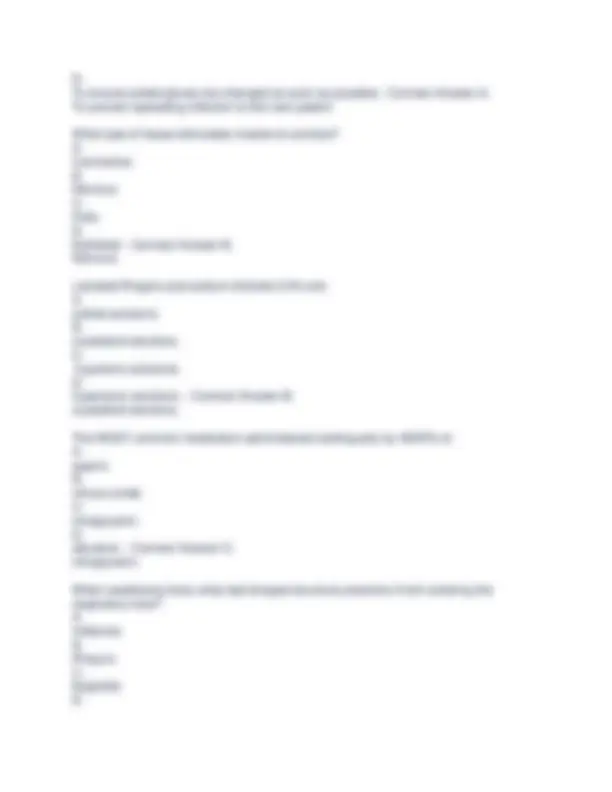
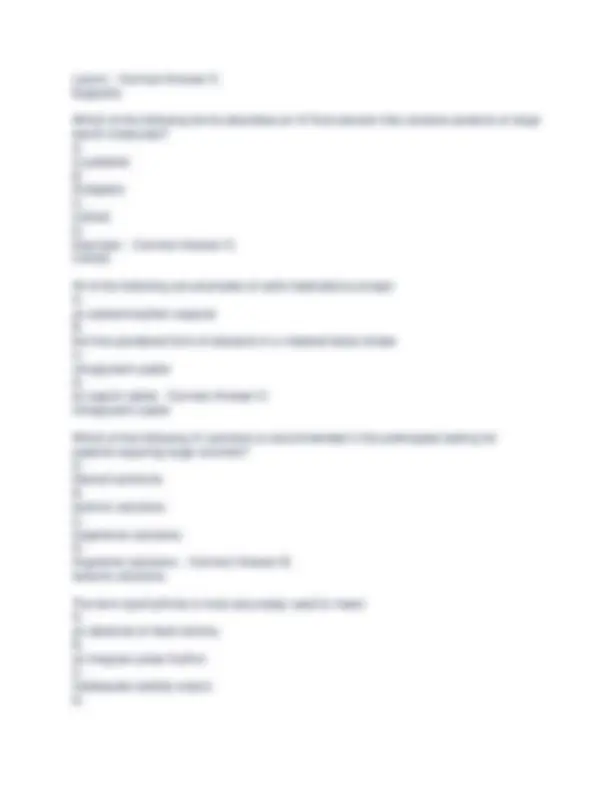
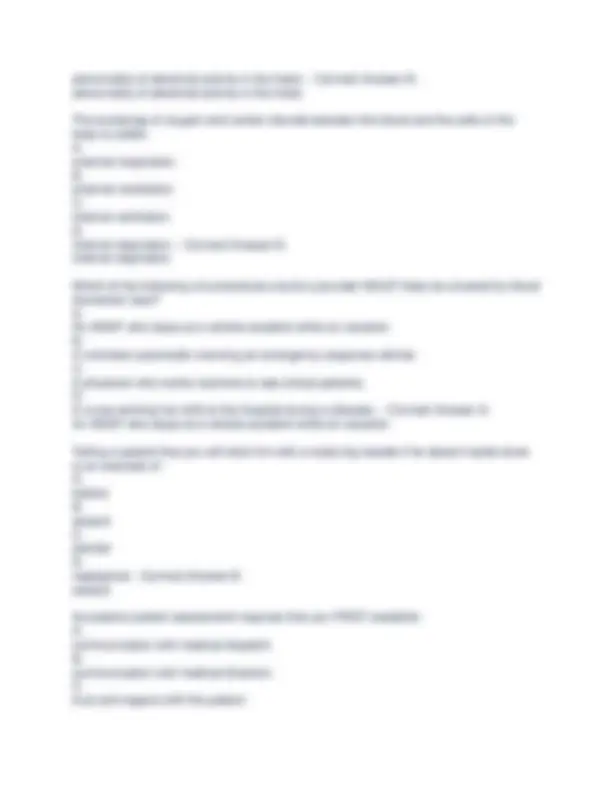
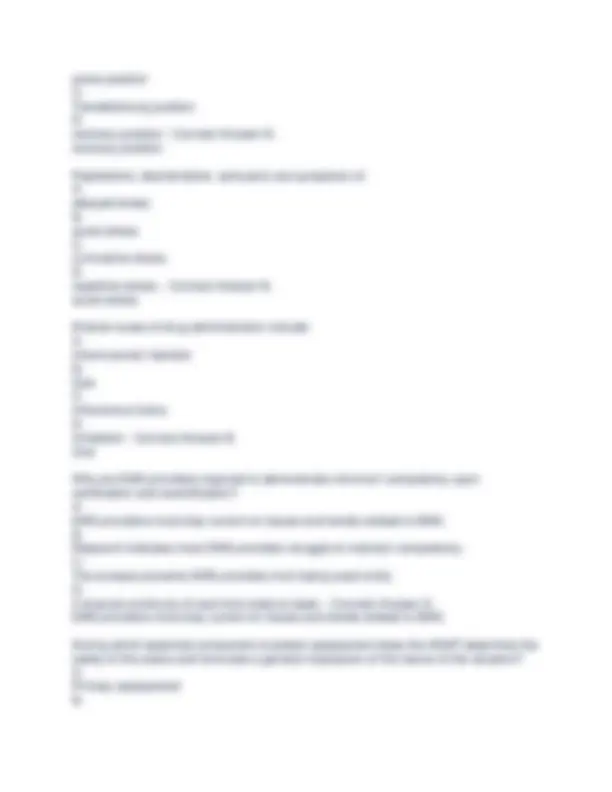
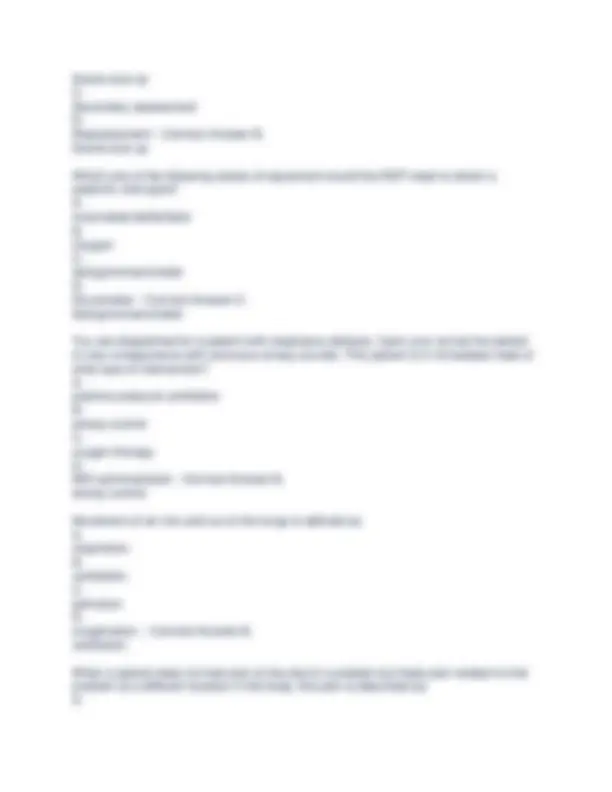
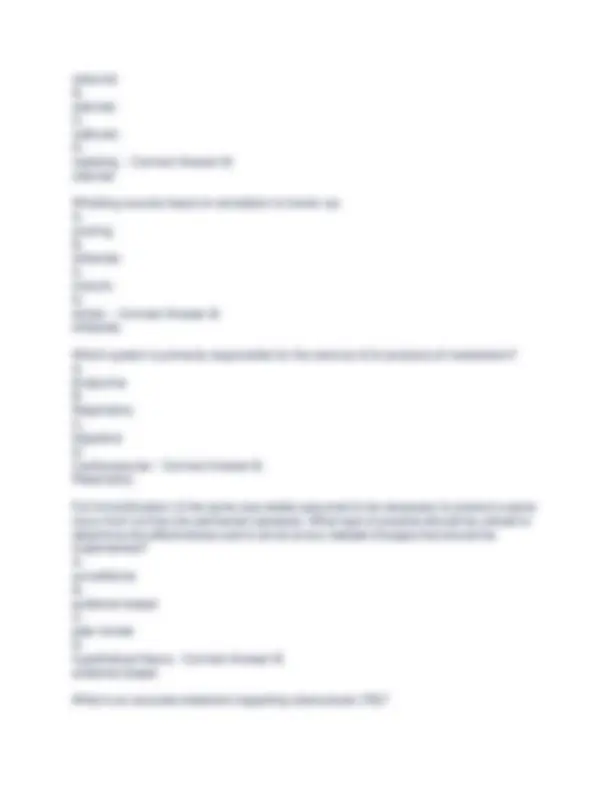
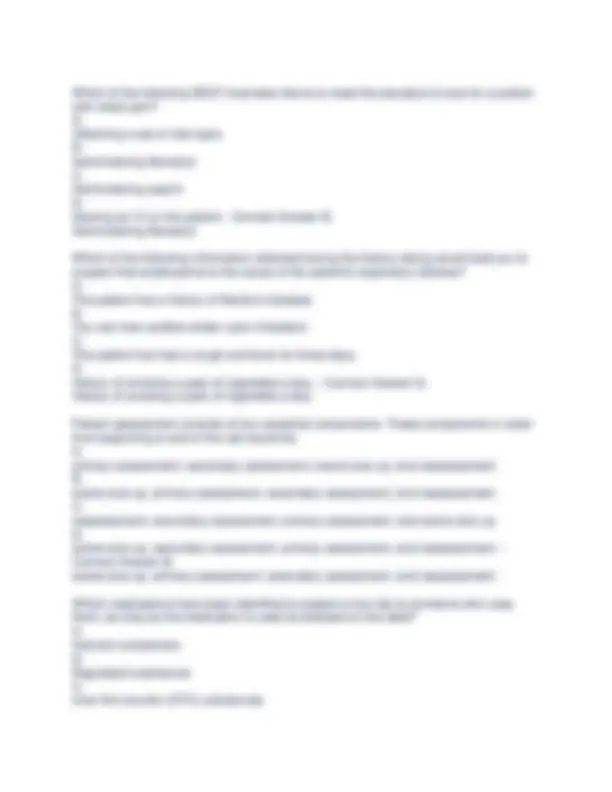
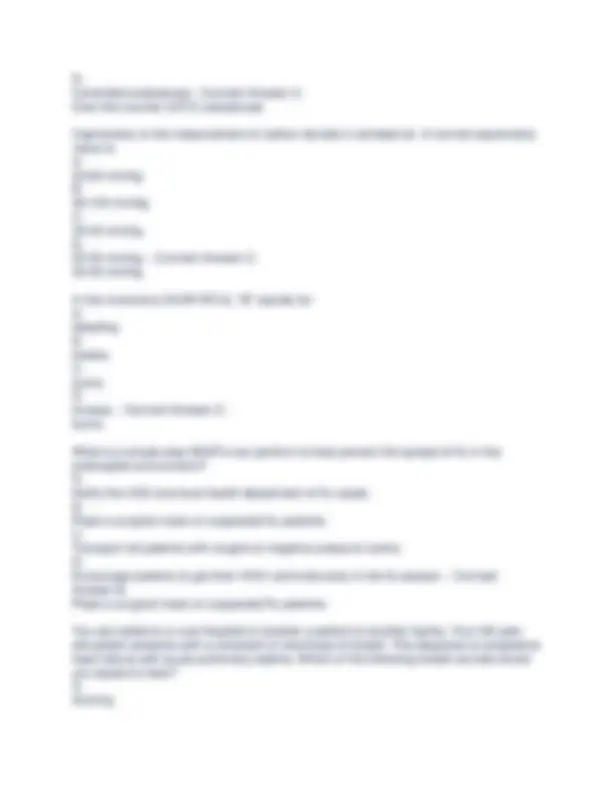
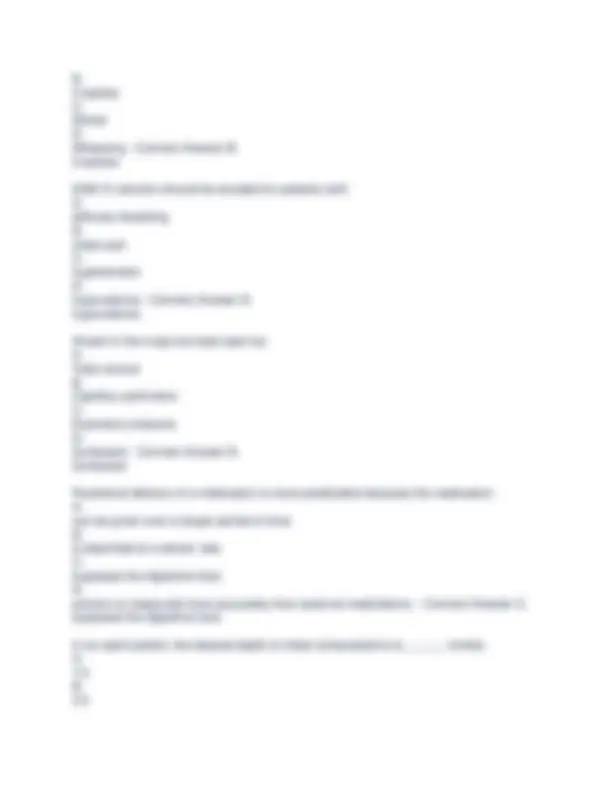
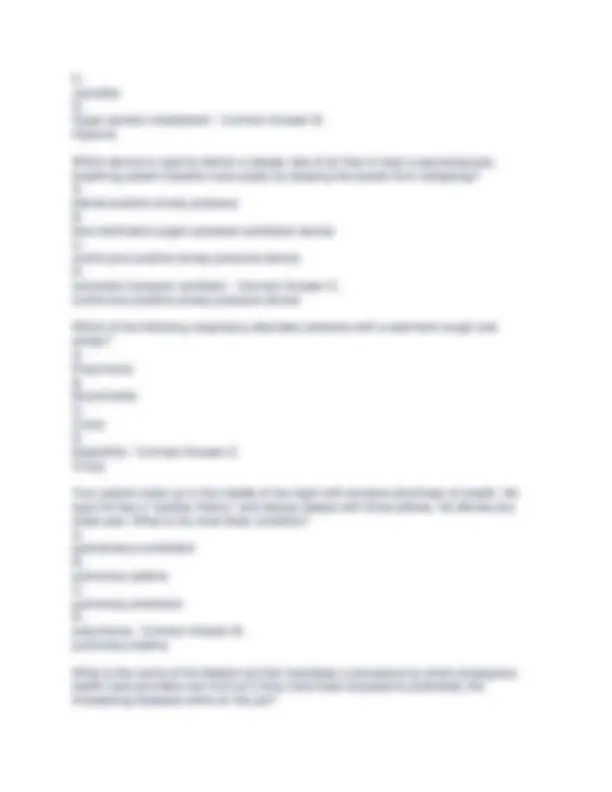
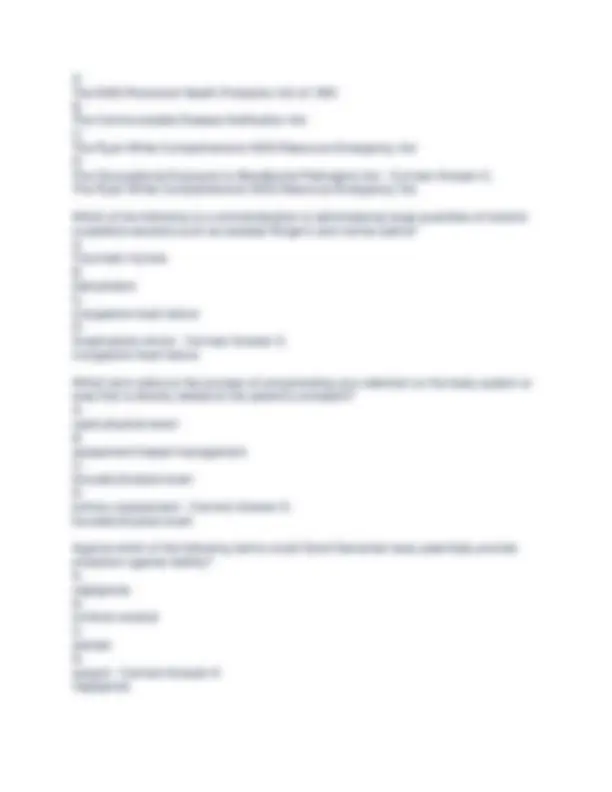
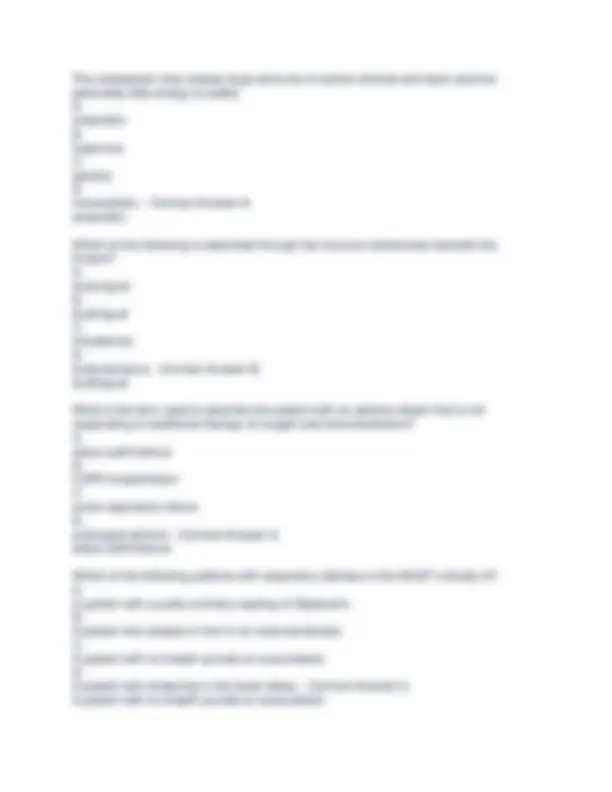
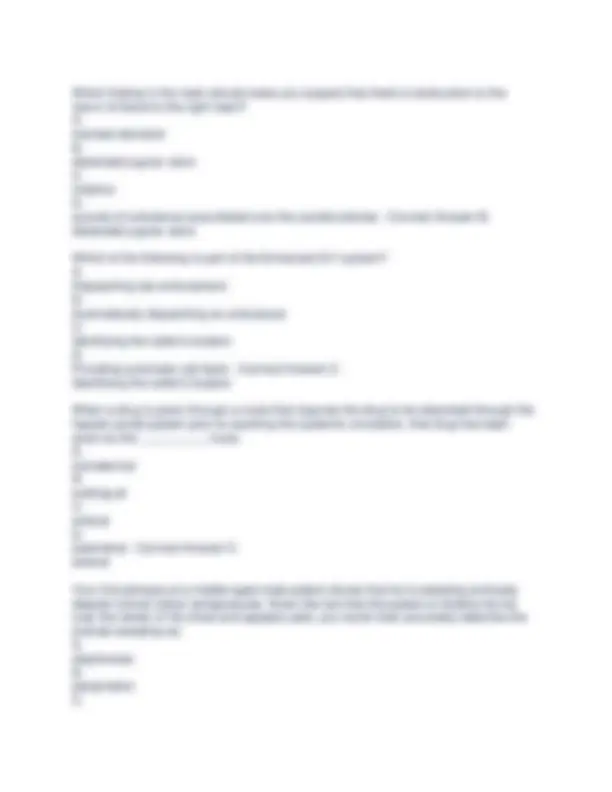
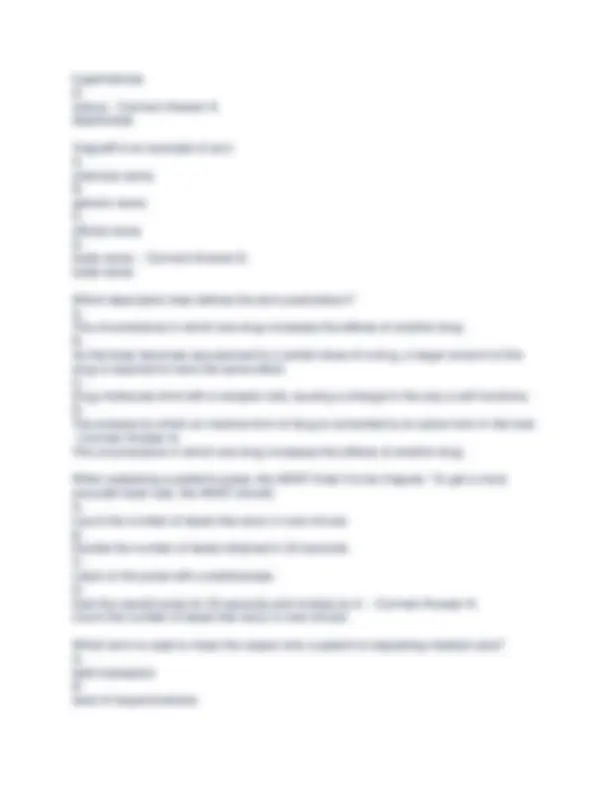
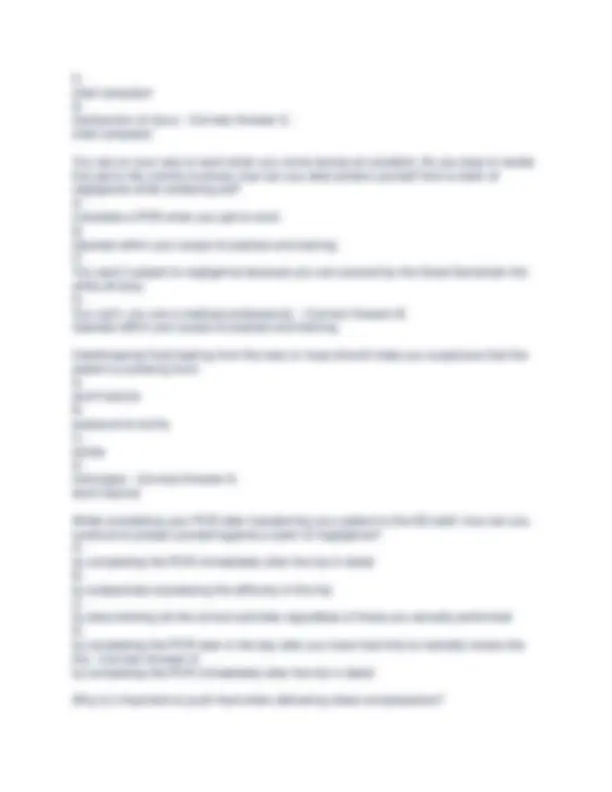
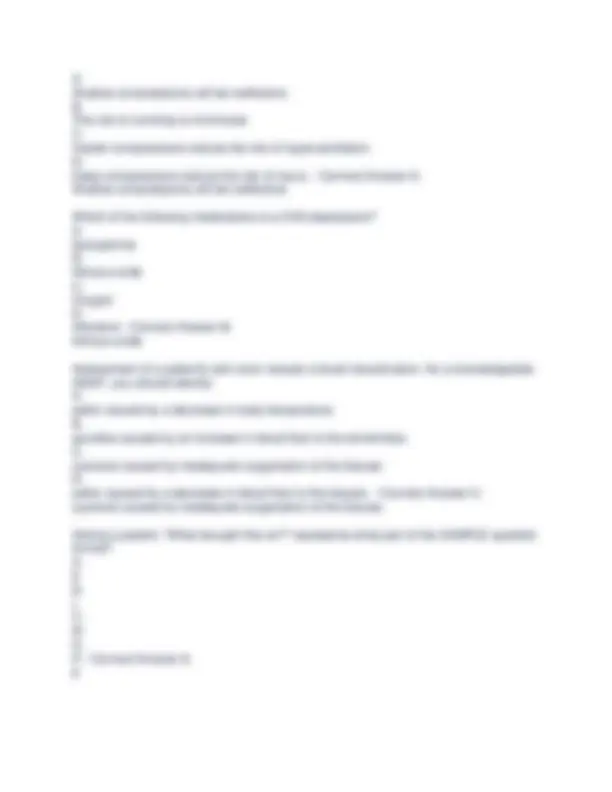
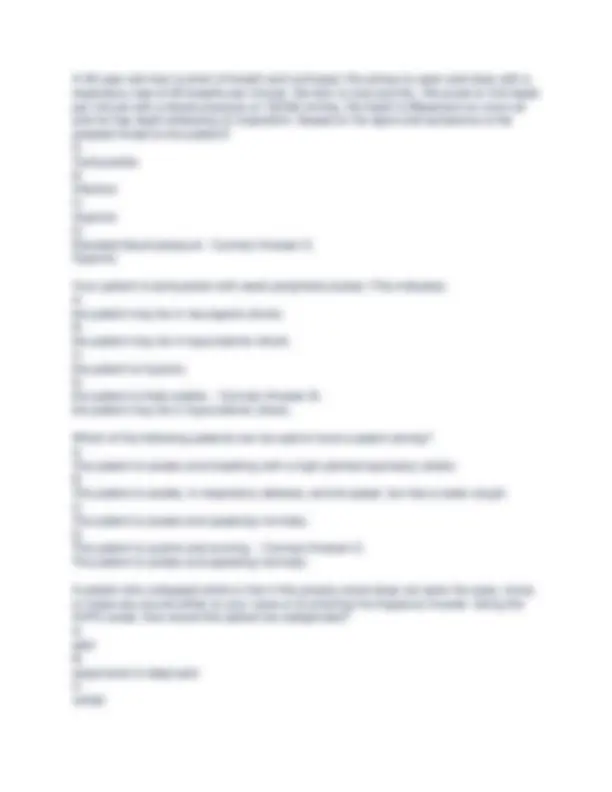
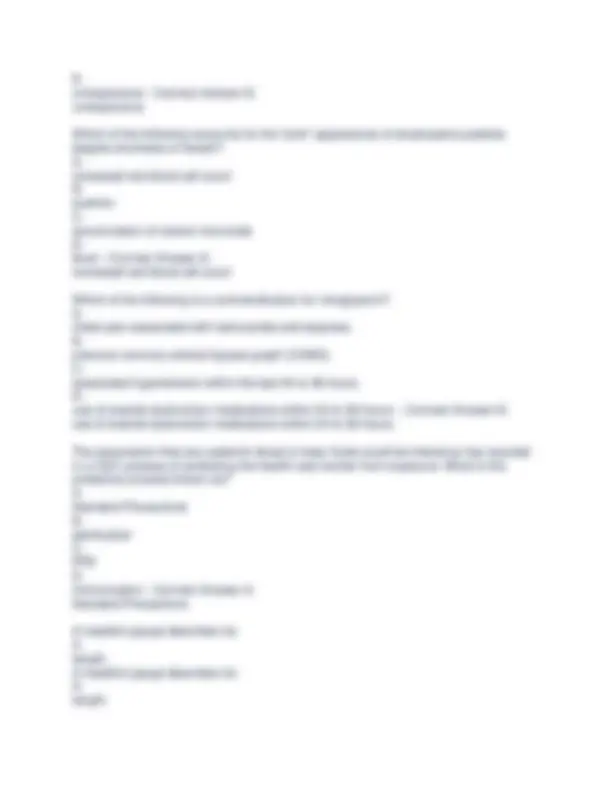
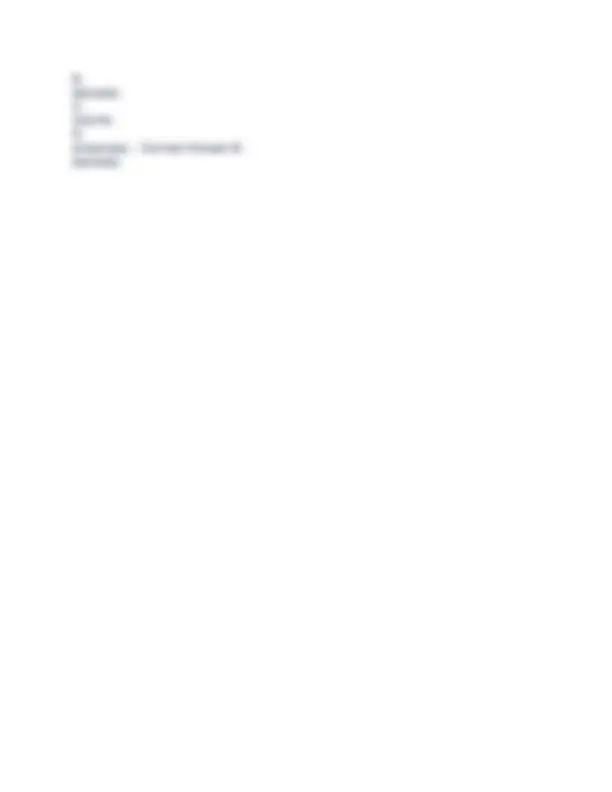


Study with the several resources on Docsity

Earn points by helping other students or get them with a premium plan


Prepare for your exams
Study with the several resources on Docsity

Earn points to download
Earn points by helping other students or get them with a premium plan
Community
Ask the community for help and clear up your study doubts
Discover the best universities in your country according to Docsity users
Free resources
Download our free guides on studying techniques, anxiety management strategies, and thesis advice from Docsity tutors
A range of topics related to emergency medical services (ems) practices and procedures. It addresses important considerations for emts and paramedics, such as patient assessment, airway management, medication administration, and documentation. Guidance on how to properly handle various medical emergencies, adhere to professional standards, and protect oneself from liability. By studying this document, readers can gain a deeper understanding of the critical role emts and paramedics play in delivering effective and safe prehospital care. The information presented can help healthcare professionals enhance their knowledge, skills, and decision-making abilities to provide the best possible care for their patients.
Typology: Exams
1 / 27

This page cannot be seen from the preview
Don't miss anything!




















A systematic process of collecting relevant patient information in order to determine a patient's medical condition and establish priorities for treatment and transport would be known as: A. primary assessment. B. patient assessment. C. scene size-up. D. reassessment. - Corrrect Answer-B. patient assessment. Of the following, the best way to avoid a claim of slander is to: A. make sure you are not overheard in public when you are making negative comments about patients B. make sure you don't write down anything derogatory about a patient C. avoid making unnecessary and unprofessional statements about patients D. save negative comments about patients only for those whom you trust absolutely - Corrrect Answer-C. avoid making unnecessary and unprofessional statements about patients Which device displays a waveform that represents the amount of carbon dioxide being detected throughout each expiration? A. CO-oximetry B. pulse oximetry C. capnography D. colorimetric capnometry - Corrrect Answer-C. capnography
A young female patient has been stung by a bee and states that her throat is "closing up." She states that she is allergic to bee stings and the last time this happened, she had to have a "tube put into my windpipe." She is struggling to breathe and can only speak a few words at a time. Knowing that allergic reactions can cause swelling in the pharynx and at the level of the larynx, which one of the following respiratory sounds would indicate that the patient indeed has swelling in this area? A. Wheezing B. Snoring C. Gurgling D. Stridor - Corrrect Answer-D. Stridor Which of the following events occurs in the stomach? A. Excess water is absorbed from food to create a solid fecal mass. B. Most of the nutrients are absorbed into the blood stream for transport to the liver. C. Food is exposed to hydrochloric acid to break its chemical bonds. D. Bile decreases the pH of the contents and breaks down fats. - Corrrect Answer-C. Food is exposed to hydrochloric acid to break its chemical bonds. Which of the following is a recommended way to bring balance to your life? A. Exercise regularly B. Challenge yourself at work C. Have a couple drinks on your day off D. Spend time rereading EMS texts - Corrrect Answer-A. Exercise regularly What would be the primary reason for an EMT to change gloves between contact with different patients? A. To prevent spreading infection to the next patient B. To protect the EMT from becoming infected C. To minimize the amount of time the EMT's hands are spent in gloves
Larynx - Corrrect Answer-C. Epiglottis Which of the following terms describes an IV fluid solution that contains proteins or large starch molecules? A. Crystalloid. B. Analgesic. C. Colloid. D. Dextrose. - Corrrect Answer-C. Colloid. All of the following are examples of solid medications except: A. an acetaminophen capsule B. the fine powdered form of albuterol in a metered-dose inhaler C. nitroglycerin paste D. an aspirin tablet - Corrrect Answer-C. nitroglycerin paste Which of the following IV solutions is recommended in the prehospital setting for patients requiring large volumes? A. Neutral solutions. B. Isotonic solutions. C. Hypertonic solutions. D. Hypotonic solutions. - Corrrect Answer-B. Isotonic solutions. The term dysrhythmia is most accurately used to mean: A. an absence of heart activity. B. an irregular pulse rhythm. C. inadequate cardiac output. D.
abnormality of electrical activity in the heart. - Corrrect Answer-D. abnormality of electrical activity in the heart. The exchange of oxygen and carbon dioxide between the blood and the cells of the body is called: A. external respiration. B. external ventilation. C. internal ventilation. D. internal respiration. - Corrrect Answer-D. internal respiration Which of the following circumstances would a provider MOST likely be covered by Good Samaritan laws? A. An AEMT who stops at a vehicle accident while on vacation. B. A volunteer paramedic manning an emergency response vehicle. C. A physician who works overtime to see critical patients. D. A nurse working her shift at the hospital during a disaster. - Corrrect Answer-A. An AEMT who stops at a vehicle accident while on vacation. Telling a patient that you will stick him with a really big needle if he doesn't settle down is an example of: A. battery B. assault C. slander D. negligence - Corrrect Answer-B. assault Successful patient assessment requires that you FIRST establish: A. communication with medical dispatch. B. communication with medical direction. C. trust and rapport with the patient.
right side D. upper body elevated - Corrrect Answer-A. supine The intent of Continuing Education (CE) is to build on entry-level professional knowledge and to: A. review material learned in school regarding patient care. B. keep informed about trends and research in EMS. C. provide an outlet to discuss problems with protocols. D. allow a forum to look for a position with another service. - Corrrect Answer-B. keep informed about trends and research in EMS. An intramuscular injection is given at a: A. 100degrees° angle. B. 15degrees° angle. C. 90degrees° angle. D. 45degrees° angle. - Corrrect Answer-C. 90degrees° angle. Which of the following provides some protection from liability for emergency care provided in good faith? A. Code of Ethics B. Malpractice Act C. Emergency Care statute D. Good Samaritan law - Corrrect Answer-D. Good Samaritan law What term is used to describe how to position patients who are breathing, but who may not be able to protect their airway, on their side to prevent airway obstruction? A. Fowler position B.
prone position C. Trendelenburg position D. recovery position - Corrrect Answer-D. recovery position Palpitations, disorientation, and panic are symptoms of: A. delayed stress. B. acute stress. C. cumulative stress. D. repetitive stress. - Corrrect Answer-B. acute stress. Enteral routes of drug administration include: A. Intramuscular injection B. Oral C. Intravenous bolus D. Inhalation - Corrrect Answer-B. Oral Why are EMS providers required to demonstrate minimum competency upon certification and recertification? A. EMS providers must stay current on issues and trends related to EMS. B. Research indicates most EMS providers struggle to maintain competency. C. The process prevents EMS providers from being sued civilly. D. It ensures continuity of care from state to state. - Corrrect Answer-A. EMS providers must stay current on issues and trends related to EMS. During which essential component of patient assessment does the AEMT determine the safety of the scene and formulate a general impression of the nature of the situation? A. Primary assessment B.
rebound. B. referred. C. radicular. D. radiating. - Corrrect Answer-B. referred Whistling sounds heard on exhalation is known as: A. snoring. B. wheezes. C. rhonchi. D. stridor. - Corrrect Answer-B. wheezes. Which system is primarily responsible for the removal of bi-products of metabolism? A. Endocrine B. Respiratory C. Digestive D. Cardiovascular - Corrrect Answer-B. Respiratory Full immobilization of the spine was widely assumed to be necessary to prevent a spine injury from turning into permanent paralysis. What type of practice should be utilized to determine the effectiveness and to arrive at any needed changes that should be implemented? A. surveillance B. evidence-based C. peer review D. hypothetical theory - Corrrect Answer-B. evidence-based What is an accurate statement regarding tuberculosis (TB)?
A TB skin test can detect exposure. Your answer is correct.B. It can be cured by any antibiotic. C. TB is not spread through surface contamination. D. The TB pathogen only affects lung tissue. - Corrrect Answer-A. A TB skin test can detect exposure. Your answer is correct. When checking for edema in a patient with suspected heart failure, which of these is a key area you should inspect? A. thoracic area of the back B. over the sternum C. sacral area of the back D. upper arms - Corrrect Answer-C. sacral area of the back Which of the following medications has primarily beta2 effects? A. Nitroglycerine B. Albuterol sulfate C. Naloxone D. Aspirin - Corrrect Answer-B. Albuterol sulfate Which of the following marks the beginning of the modern history of EMS? A. The Highway Safety Act of 1970 B. Publication of the National Standard Curriculum C. Accidental Death and Disability: The Neglected Disease of Modern Society D. Omnibus Budget Reconciliation Act - Corrrect Answer-C. Accidental Death and Disability: The Neglected Disease of Modern Society
Which of the following BEST illustrates failure to meet the standard of care for a patient with chest pain? A. Obtaining a set of vital signs B. Administering Benadryl C. Administering aspirin D. Starting an IV on the patient - Corrrect Answer-B. Administering Benadryl Which of the following information obtained during the history taking would lead you to suspect that emphysema is the cause of the patient's respiratory distress? A. The patient has a history of Marfan's disease. B. You can hear audible stridor upon inhalation. C. The patient has had a cough and fever for three days. D. History of smoking a pack of cigarettes a day. - Corrrect Answer-D. History of smoking a pack of cigarettes a day. Patient assessment consists of four essential components. These components in order from beginning to end of the call would be: A. primary assessment, secondary assessment, scene size-up, and reassessment. B. scene size-up, primary assessment, secondary assessment, and reassessment. C. reassessment, secondary assessment, primary assessment, and scene size-up. D. scene size-up, secondary assessment, primary assessment, and reassessment. - Corrrect Answer-B. scene size-up, primary assessment, secondary assessment, and reassessment. Which medications have been identified to present a low risk to someone who uses them, as long as the medication is used as directed on the label? A. Narcotic substances B. Regulated substances C. Over-the-counter (OTC) substances
Controlled substances - Corrrect Answer-C. Over-the-counter (OTC) substances Capnometry is the measurement of carbon dioxide in exhaled air. A normal capnometry value is: A. 50 - 60 mmHg. B. 90 - 100 mmHg. C. 35 - 45 mmHg. D. 20 - 30 mmHg. - Corrrect Answer-C. 35 - 45 mmHg. In the mnemonic DCAP-BTLS, "B" stands for: A. bleeding. B. breaks. C. burns. D. bruises. - Corrrect Answer-C. burns. What is a simple step AEMTs can perform to help prevent the spread of flu in the prehospital environment? A. Notify the CDC and local health department of flu cases. B. Place a surgical mask on suspected flu patients. C. Transport all patients with coughs to negative pressure rooms. D. Encourage patients to get their H1N1 antivirals early in the flu season. - Corrrect Answer-B. Place a surgical mask on suspected flu patients. You are called to a rural hospital to transfer a patient to another facility. Your 68 - year- old patient presents with a complaint of shortness of breath. The diagnosis is congestive heart failure with acute pulmonary edema. Which of the following breath sounds would you expect to hear? A. Snoring
2.0 - Corrrect Answer-D.
You are evaluating a patient who was in a motor vehicle collision. You determine that the patient is responsive to pain only and has a partially amputated arm at the elbow, a possible pelvic fracture, and a flail chest. You classify this patient's condition as: A. critical. B. secondary. C. isolated. D. expectant. - Corrrect Answer-A. critical. Which route of medication administration allows an almost immediate onset of action? A. intramuscular B. oral C. subcutaneous D. intravenous - Corrrect Answer-D. intravenous The four basic sources of medications are: A. plant, animal, metallic, and synthetic. B. man-made, plant, synthetic, and metallic. C. animal, man-made, metallic, and mineral. D. plant, animal, mineral, and synthetic. - Corrrect Answer-D. plant, animal, mineral, and synthetic. Which of the following represents a public safety model of EMS? A. Fire based service B. Municipal third service
Private service D. Tiered service - Corrrect Answer-B. Municipal third service Assessment of a72-year-old man reveals absent lung sounds to the left lung accompanied by sharp chest pain on the same side. When obtaining the history, which of the following statements made by his wife is MOST important? A. "He has had a fever since last night." B. "He has chronic obstructive pulmonary disease." C. "He did not take his medications today." D. "He just saw his doctor yesterday." - Corrrect Answer-B. "He has chronic obstructive pulmonary disease." Which of the following is a contraindication for nitroglycerin? A. associated hypertension within the last 24 to 36 hours. B. chest pain associated with tachycardia and dyspnea. C. use of erectile dysfunction medications within 24 to 36 hours. D. previous coronary arterial bypass graph (CABG). - Corrrect Answer-C. use of erectile dysfunction medications within 24 to 36 hours. The body's transition between normal function and death is called: A. hemorrhage. B. shock. Your answer is correct.C. exsanguination. D. homeostasis. - Corrrect Answer-B. shock. What occurs when the body's need for oxygen exceeds the available oxygen supply? A. Hypotension B. Hypoxia
The EMS Personnel Health Protection Act of 1991 B. The Communicable Disease Notification Act C. The Ryan White Comprehensive AIDS Resource Emergency Act D. The Occupational Exposure to Bloodborne Pathogens Act - Corrrect Answer-C. The Ryan White Comprehensive AIDS Resource Emergency Act Which of the following is a contraindication to administering large quantities of isotonic crystalloid solutions such as lactated Ringer's and normal saline? A. Traumatic injuries B. Dehydration C. Congestive heart failure D. Anaphylactic shock - Corrrect Answer-C. Congestive heart failure Which term refers to the process of concentrating your attention on the body system or area that is directly related to the patient's complaint? A. rapid physical exam B. assessment-based management C. focused physical exam D. primary assessment - Corrrect Answer-C. focused physical exam Against which of the following claims could Good Samaritan laws potentially provide protection against liability? A. negligence B. criminal conduct C. slander D. assault - Corrrect Answer-A. negligence
The metabolism that creates large amounts of carbon dioxide and lactic acid but generates little energy is called: A. anaerobic. B. hyperoxic. C. aerobic. D. homeostatic. - Corrrect Answer-A. anaerobic. Which of the following is absorbed through the mucous membranes beneath the tongue? A. Subungual B. Sublingual C. Intradermal D. Subcutaneous - Corrrect Answer-B. Sublingual What is the term used to describe the patient with an asthma attack that is not responding to traditional therapy of oxygen and bronchodilators? A. status asthmaticus B. COPD exacerbation C. acute respiratory failure D. prolonged asthma - Corrrect Answer-A. status asthmaticus Which of the following patients with respiratory distress is the MOST critically ill? A. A patient with a pulse oximetry reading of 93percent. B. A patient who speaks in five or six word sentences. C. A patient with no breath sounds on auscultation. D. A patient with wheezing in the lower lobes. - Corrrect Answer-C. A patient with no breath sounds on auscultation.